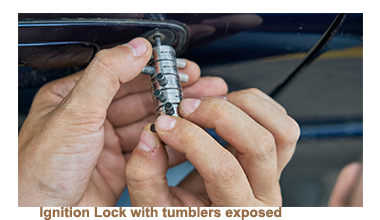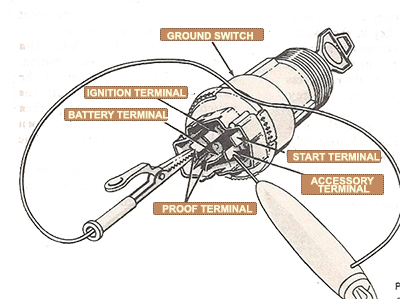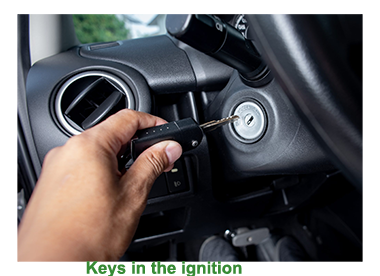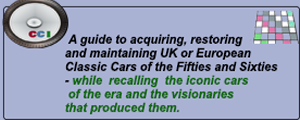
One of the most feared scenarios among the UK and European classic car restoration community is when they discover that the original ignition or door keys ( or both) have gone missing or simply not available through conventional channels.
 Vehicles of today rely on coded electronic fobs and there appears to be dealer key service on every corner, but for a keyless classic car owner the world can be very lonely place. Classic car mechanical lock systems are known to be difficult to replace, and while it would be very tempting to replace the lock with a coded version, both the mechanical integrity and the historical authenticity of the vehicle will be threatened.
Vehicles of today rely on coded electronic fobs and there appears to be dealer key service on every corner, but for a keyless classic car owner the world can be very lonely place. Classic car mechanical lock systems are known to be difficult to replace, and while it would be very tempting to replace the lock with a coded version, both the mechanical integrity and the historical authenticity of the vehicle will be threatened.
 However, with the right approach and some patience, it is possible to regain access and usability while preserving the vehicle’s originality.
However, with the right approach and some patience, it is possible to regain access and usability while preserving the vehicle’s originality.
Classic cars from the Fifties and Sixties typically used simple mechanical locks that relied on physical key blanks, cut to a specific code.
 In the more trusting atmosphere that prevailed in these years, these codes were simply and openly stamped onto the key as well as being clearly marked in the vehicle’s original logbook.
In the more trusting atmosphere that prevailed in these years, these codes were simply and openly stamped onto the key as well as being clearly marked in the vehicle’s original logbook.
Unfortunately, over time, logbooks get lost, invaluable codes are misplaced, and the manufacturers or dealerships that once supplied blanks have closed their doors and have no records available
Add that to the fact that the majority of classic cars that have been on the road for seventy years have had locks changed or modified during their long and eventful lives, meaning that even if the key code has been kept, there is a very strong chance that they no longer match the existing lock set.
 Before doing anything drastic the frustrated restorer should take a step back from the chasm and begin to search the vehicle existing codes. There are a few classic UK and European models that have codes stamped directly onto their lock barrels, usually in the glove box and sometimes in the boot locks.
Before doing anything drastic the frustrated restorer should take a step back from the chasm and begin to search the vehicle existing codes. There are a few classic UK and European models that have codes stamped directly onto their lock barrels, usually in the glove box and sometimes in the boot locks.
Jaguar and Rover are known to carry such markings.
If the lock can be removed without a key, noting this code may allow a locksmith or specialist supplier to cut a new key. Classic car clubs and forums often maintain databases of key code ranges, which can prove invaluable.
 If no code can be found, then the inevitable has to be faced, and that entails calling for outside help, in the form of a professional locksmith, preferably situated locally, who has the necessary expertise in classic vehicles.
If no code can be found, then the inevitable has to be faced, and that entails calling for outside help, in the form of a professional locksmith, preferably situated locally, who has the necessary expertise in classic vehicles.
The locksmith may well be capable of creating to create a replacement key by a procedure known as “impressioning”.
Impressioning is basically as simple process that involves inserting a blank key into the lock and filing it gradually so that it matches the positions of the tumblers. While time-consuming, impressioning avoids the need to replace original locks and preserves authenticity while producing remarkably high results.
Another option involves re-pinning the locks. Re-pinning involves dismantling the barrel, removing the original tumblers, and fitting new ones to suit a fresh key. Re-pinning allows for the retention of original external lock housing, thus retaining the period-correct look while enabling secure operation.
In the event that the locksmith does not succeed or if the lock has been badly damaged, the only remaining alternative is to replace the lock barrels.
Many classic car suppliers still provide reproduction ignition switches, door handles, and boot locks. Although this will affect originality standard, it does ensure continued usability.
Another potentially very useful source of information for restorers who have reached an impasse is to turn to owners’ clubs for information and assistance, relating to the particular model being restored or maintained.
There have been a few instances where a full assembly, either used and even stock, has been sourced and the problem solved.
For collectors, originality is crucial.
 Whenever possible, it is preferable to repair and reuse the existing lock hardware rather than install reproduction parts. Re-keying and impressioning services are therefore highly valued. Where replacements are unavoidable, it is wise to retain the original lock components for provenance, even if they are no longer functional.
Whenever possible, it is preferable to repair and reuse the existing lock hardware rather than install reproduction parts. Re-keying and impressioning services are therefore highly valued. Where replacements are unavoidable, it is wise to retain the original lock components for provenance, even if they are no longer functional.
 Once hopefully the problem has been solved, lessons must be learned.
Once hopefully the problem has been solved, lessons must be learned.
These lessons involve cutting at least two sets of duplicate keys, which ate lease one of them in the safe hands of a trusted friend or close relative. If the car is valuable enough, the duplicate keys can be kept in a safe deposit box. In addition, all of the key codes should be documented and also kept in a secure place
Such precautions, while appearing overly elaborate, should ensure that the inconvenience and discomfort of keys going missing should never happen again.
ae4

